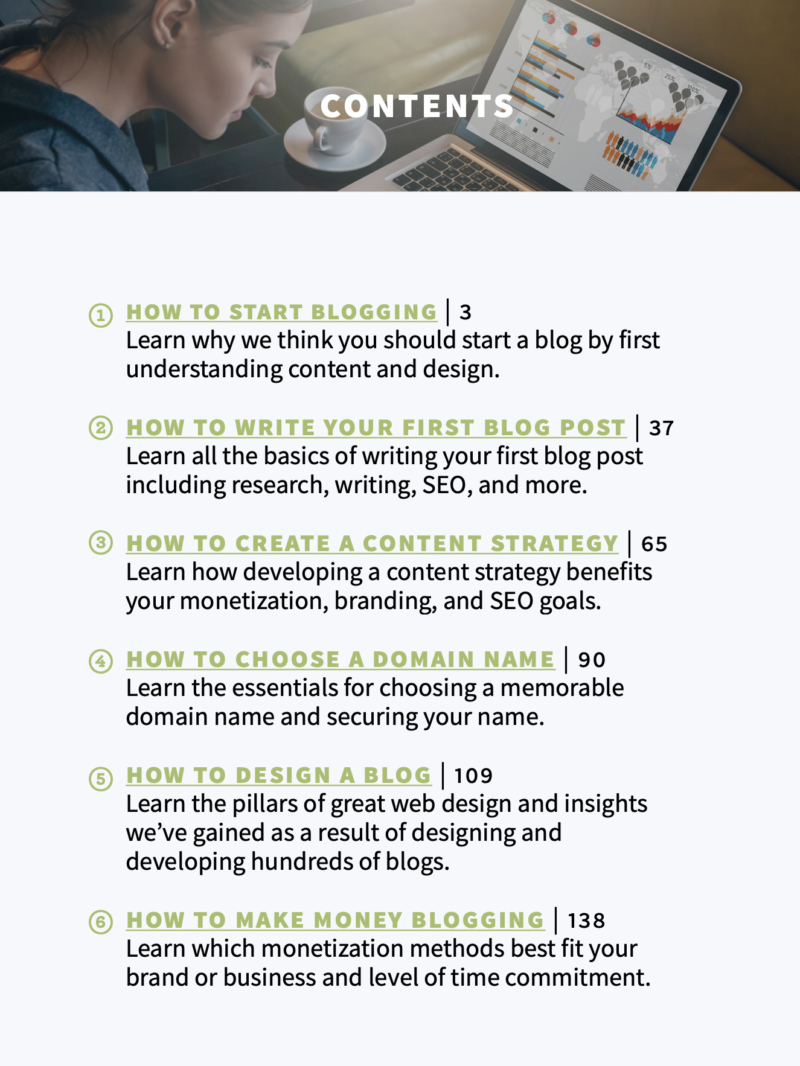Engage Your Audience
The way your leads interact with you has changed. Publishing a few pages to the web just isn’t going to cut it anymore. And asking all new visitors for their email as their first interaction on your site isn’t the way to go either. Generally speaking, the average conversion rates for email submissions are less than 2%. To make your lead generation efforts a success there is a lot more to consider.
Today, your potential customers want to learn about your company and be sold on you. They don’t want some faceless organization cold calling them about stuff they’re not even interested in. Your sales team and marketing team need to be on the same page when it comes to creating a bomb marketing strategy. This is where content marketing and your blogging strategy come in.
Take a look at the websites of some of the top companies in the marketing industry as well as those of top marketing influencers. They are hubs of information with almost all interactions designed to engage their audience. This establishes you as an authority that people can trust and want to buy from. Not to mention it makes Google and other search engines pretty darn happy when you have tons of high-quality content that people drink up like the nectar of life itself.
You can engage your audience on your website throughout the entire customer lifecycle using “on-site marketing.” When you do, you will turn your website into a marketing channel that generates high quality leads at each stage of your sales funnel.
BizBudding has the experience and tools to help you give your visitors the ability to guide themselves to the content that is most valuable to them. Then, to generate new customers, you present your visitors with offers most relevant to what they need.
Capture, Qualify, and Segment Leads on Your Website
You can use an information architecture plan to determine what content areas should be dynamic and what digital assets you have that work in your marketing funnel. In order to effectively implement a lead generation plan, you need to have clear objectives for each tier in your marketing funnel.
We can help you identify your marketing funnel flow and your marketing funnel assets to have maximum impact on your lead generation efforts. Once we have that established, we can work with you to create on-site retargeting campaigns with dynamic calls-to-action (CTAs) designed to capture and convert your users based on lead segmentation and their behavior on your site.
Marketing Campaigns
High-converting marketing campaigns are every website’s goal.
You need to create innovative and clever ways to deliver personalized experiences for audiences. Here are some lead generation ideas:
- Use video to connect with your visitors and better communicate the value you can provide to them.
- Welcome every visitor to your site with a quick question asking about who they are, so you can personalize all their future CTAs and messages they see.
- Use design congruence—a conversion-centered design principle—to create a consistent experience that builds trust with your visitors.
- Deliver personalized CTAs at the bottom of your blog posts to help your target audience take the next step.
- Guide your audience to take action by embedding a quiz on your website.
- Guide returning leads who’ve shown interest in your products/services to content-rich landing pages that educate them on a deeper level.
Connect All Marketing Channels
Your social media strategy and email marketing automation can and should be interconnected with your lead generation campaigns. LinkedIn is especially useful for b2b lead generation, whether you want to capture sales leads or establish relationships with potential partners or affiliates. We can you help you establish which channels are right for you and your audience and then create a plan that allows them to work together seamlessly.
You use a lead generation tool to create a cohesive marketing and on-site retargeting plan. To understand how your users are landing on your site, you can identify the referral source of each visitor, whether they are coming from a particular social network or your email marketing campaigns. This is especially usefully in determining how much resources to allocate to that particular marketing channel for similar campaigns in the future.
BizBudding can help you put together effective lead generation strategies that connect your social media, email drip campaigns, and all inbound marketing to generate leads much faster with higher lead quality. We can measure and track your users’ progress through your funnel and which campaigns are most effective so your re-targeting strategy continues to evolve.
A Marketing Funnel Matters
Top of Funnel
Guide New Visitors (Segment)
You’ll want to begin your lead generation process by first identifying who your visitors are and the problem they are looking to solve. These visitors are typically not in your CRM. Your goal is to help them find the information they need, ultimately to discover the value of your solution. As you guide them, you can segment them into groups based on what they identify as their biggest pain point, who they are, what they are interested in, etc.
Use unobtrusive CTAs that pop up in the corner of the screen to ask questions like: What is your biggest challenge with [topic]? or What can we help you find today? Give them a few options (3 is a nice number, too many can give people analysis paralysis), then tag them based off their choice and redirect them to some appropriate content or show them a video that helps them learn more. Now that they are segmented, you can better target them in the future, or even segment them further, depending on what you want to achieve.
There are a lot of possibilities with segmentation, and it can be easy to get overwhelmed trying to figure out the right questions to ask or content to promote. That’s why it is so critical to have your sales funnel mapped out prior to creating specific CTAs, so you always have in mind your key objectives.
Capture Returning Visitors (Attract)
Think about this: How often do you visit a website for the first time and immediately sign up for their email list? We’d venture to guess almost never. That’s because during your first visit you are still in the information gathering stage. If you decide on a return visit, now you are much more likely to pony up your contact details.
Returning visitors are at the psychological stage where they are more likely to sign up for an email list because they’ve learned a bit about you and deemed you worthy of more of their time. You can attract these potential leads by offering a free resource such an eBook, case study, or video, tailored to something they have already expressed an interest in. (See! Those segmentation questions are not a waste of time!)
For example, if during a previous visit, a user expressed an interest in raising chickens and visited a blog post about building a chicken coop, you can grab their attention with a free PDF that outlines step by step building plans. All they have to do is enter their email, and they’re on their way to the best chicken palace on the block.
Middle of Funnel
Capture and Nurture Returning Leads (Close)
There is an appropriate time to close the sale contrary to the mantra, “Always Be Closing,” and this is it. Target qualified leads—those whose contact information you’ve already captured and who’ve shown interest in your products or services—with customized calls-to-action that drive them to take the next step. Here are some CTA examples:
- Remind them they are forgetting something awesome (cart abandonment).
- Give more information about your offering.
- Establish their biggest objection (then eliminate it).
- Share testimonials.
- Provide a contact form for a demo.
- Offer a special discount.
Bottom of Funnel
Convert and Expand Customers (Grow)
At this point in your funnel, your goal is to grow and maintain your customer relationships. You should target these visitors with upsells, cross-sells, and repeat purchase CTAs. If you add new products or services to your offerings, these folks will be much more receptive to hearing about these as well.
During this stage, it’s important that you continue to educate these visitors about your company to keep them engaged and build their status as a member of your tribe. You can welcome them with an onboarding message, inquire if they’d be interested in your referral program, share company updates, and ensure they are always seeing the content they are most interested in.
Learn More About Lead Generation
Lead Segmentation
Lead Segmentation is the process of grouping your users based on their demographics or how they have interacted with your site. You can utilize tags to segment your audience and send them relevant content via email or display dynamic content on your site based on where they are in your marketing funnel.
Calls-to-Action – CTAs
A call-to-action is the action you are asking your user to take such as “Learn More,” “Get Started,” or “Buy Now.” By using a call-to-action, the next step is clear and simple and the user is much more likely to convert.
On-Site Retargeting
On-site retargeting is a personalized way to guide people on their journey through your website. You can use lead generation software for on-site retargeting. On-site retargeting allows you to create dynamic CTAs that will target users based on their tags or other conditions you assign. You can display unique messages that are specific to leads, customers, repeat buyers, and whatever other segments of your audience you have identified as important. These CTAs will guide each visitor to automatically take action, based on who they are and what they’re interested in, and their previous actions on your website.
Landing Pages
Landing pages are specialized web pages designed to capture the visitor’s information, usually email address, with an opt-in form. Landing pages present some type of compelling offer such as a free trial, ebook, or whitepaper to entice the viewer to sign up. If you want to get a specific audience to your site, you need to have a place to send them that is also specific to your campaign or goal.
Email Drip Campaigns
Email drip campaigns are a form of marketing automation that keeps your users engaged based on where they are in the customer lifecycle or how they are segmented (through tags). Email drip campaigns also allow you to trigger email automations based on time periods or user action so that your audience receives the right emails at the right time. To get the most out of your email drip campaigns we suggest connecting them to your on-site retargeting plan. For example, if someone signs up for a webinar on your site, you can tag them in your email marketing system, add them to a list, and then send them an automated thank you email that confirms their sign up and presents them with the webinar link.
Read More Content on Lead Generation
Download the How to Start Blogging Guide
Explore this FREE GUIDE to take a deep dive into how to start blogging to make money. Get a PDF version of this guide right to your email, plus weekly tips from our blogging experts at BizBudding.









